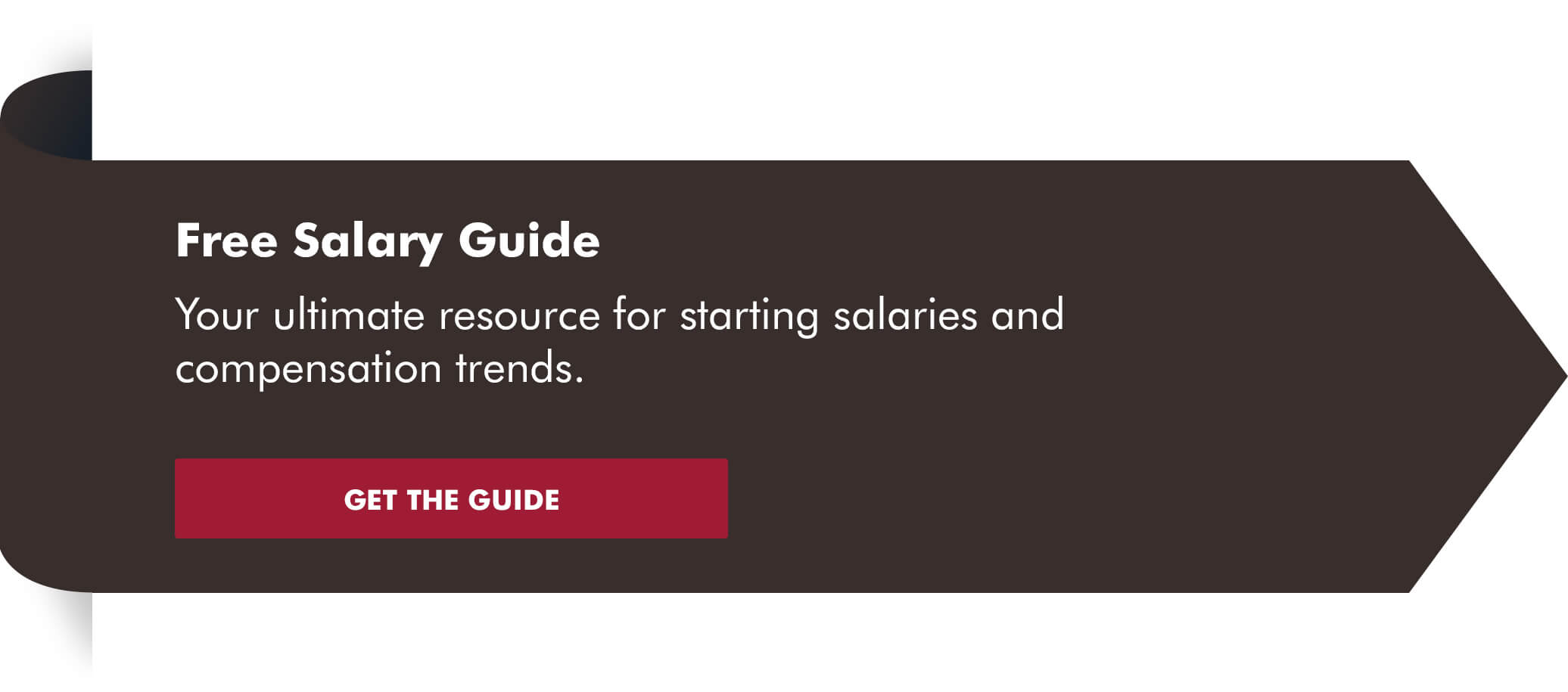Businesses across industries are racing to adopt emerging technologies, like augmented reality and artificial intelligence (AI), so they can work smarter and create better products and experiences for their customers. To get the most from these investments, they need a team of multiskilled and adaptive creative professionals. But technology is evolving so fast, it’s hard for even seasoned practitioners to keep pace.
In fact, nearly nine in 10 creative professionals who responded to a Robert Half survey said it will be challenging to keep their skills up to date as they advance in their careers.
It’s understandable if you, like many creative professionals, feel insecure about your current — and future — marketability. One look at the in-demand skills list in the Robert Half Salary Guide might deepen your concern, especially if you’re just launching your creative career. That list shows employers increasingly seek candidates with proficiency in areas such as data science and machine learning for a variety of creative roles. Those are high expectations given those skills are already hard to find.
Human skills are key to creative inspiration
All creative pros are wise to learn technology skills relevant to their job or industry, of course. You may also want to build a fundamental understanding of AI and it’s growing role in design, as industry experts like Ashleigh Axios advise. In addition, you should focus on refining another vital skill set — your human skills — if you want to achieve long-term success in an increasingly tech-driven creative industry.
Several creative leaders underscore this point:
Moira Cullen, vice president and global creative director at method products pbc.; Pum Lefebure, cofounder and chief creative officer of Design Army; and Eddie Opara, a partner at Pentagram.
Cullen, Lefebure and Opara each strongly recommend that creative professionals detach from technology as often as possible to find inspiration in “the real world.” They also stress that fundamental human skills — such as knowing how to explain your design process — are essential for all creative pros, no matter how adept they are at using the latest tech tools. Read on for more of their insights and advice, which will come in handy as you look to further your creative career in the digital era.
Design is a relational profession
Cullen, who has held senior creative leadership positions at companies like Coca-Cola, Hallmark Cards, the Hershey Company, and PepsiCo, says technology can be a great friend to designers. It gives them more time to focus on the work they love, and helps them create and experiment with new ideas faster than ever before.
Even so, the human factor in design remains essential. Cullen says that no matter how much creative work becomes automated, designers still need to be in touch with the human soul.
“Designers are pioneers, always pushing into new places. But that comes from human curiosity, not technology,” Cullen explains. “What we produce is for the human experience. And only humans right now can discern that unquantifiable nuance between ‘magic’ and ‘just good enough,’ which is vital to great creative work.”
Cullen says that when she’s hiring creative talent, she weighs the following questions:
- Who can bring extra dimension to my team?
- What is their ability to communicate, collaborate, influence and show empathy?
The latter human skills are especially important as designers become increasingly reliant on technology. “At some point in the design process, there needs to be a human interface. How does what a machine makes get out into the world? People have to formulate it, present it, and galvanize other people around it,” she says.
Cullen’s advice to designers, especially those just entering the profession, is to not be duped by technology’s ability to make certain aspects of work easier: “Technology offers an entry point into design. Many designers create something with programmatic efforts and think, ‘Wow, that was easy.’ But then, when they want to customize it, they find that the program can’t help them. They need to apply a professional mind and eye to make something more meaningful, differentiated and extraordinary.”
We can help you find your next creative job:
Take a break from technology for inspiration
Lefebure has led teams that have developed high-profile campaigns for clients worldwide, including the Academy Awards, Adobe, Disney, PepsiCo and Ritz Carlton. Rapid technological change has — and continues to be — a constant reminder that what they’re doing right now might not be relevant in six months or a year, so they must keep learning. “Change is part of a designer’s job,” she says. “You must keep looking forward and anticipating trends.”
Check out our Q&A with Pum Lefebure here.
Lefebure says she loves technology but is also “old school” when it comes to finding sources of inspiration. “If you only see what’s on the internet, you’re not looking at real life,” says Lefebure. “It’s crucial to go out and see things in the real world.”
She offers an example, based on her own recent travel experience, of how disconnecting from technology can provide powerful inspiration: “Say you want to see examples of white ceramics from France. You do an internet search — and boom! — it’s all right there in front of you. But now, think about this: You go to Paris and find an antiques dealer at a flea market. You browse the tables. You hear people speaking French. You feel the wind blowing and the sunshine. You take in the smells of the market. Then you see it: a gleaming white ceramic jug. You grab it by the handle and feel its weight and coolness. You tap it to hear its sound. That is a much more human, sensory experience, no?”
While it may not be possible for you to spend an afternoon strolling a Parisian antique market, Lefebure emphasizes that creative inspiration can be found anywhere you go, whether it’s a local park or museum. “Just get out and clear your head. We are all so glued to technology now. We must decompress — especially designers,” she says.
And when you can’t get outside, Lefebure says books can be a good substitute, but not ones about graphic design. “I don’t look at those anymore, although I used to in my 20s. Now, I prefer to look at books about interior design, fashion or art. But still, above all else, I prefer to walk around and do real research. The world is so much deeper than what you can see in books or on the internet.”
Hiring creative professionals? We can help:
Your job isn’t just a job — it’s a profession
Opara is a multifaceted designer whose work encompasses strategy, design and technology. His clients have included the Morgan Stanley, New York University, Santander, Smithsonian Design Museum and St. Regis Hotels, to name a few. He’s also a senior critic at the Yale University School of Art. And like Lefebure, Opara encourages designers to go out in the real world to find inspiration.
While Opara recognizes that technology can be a tremendous help to designers, it can also do more harm than good. He says too many designers are coming out of school with no understanding of process. Opara explains, “You’re not going to be hired just on the principles of the solution you came up with, even if the aesthetics are good. You need to be able to explain, including in writing, how you came up with that solution. Unfortunately, many designers can’t do that.”
He continues, “I find that disheartening as I think about the future for the creative field. Too many designers today look at their jobs as jobs — and not as a profession. They have to ask themselves, ‘Do I want to be a producer of work or a person who comes up with breakthrough ideas?’ Being conceptually minded will earn you respect.”
Opara says a lack of understanding about historical factors behind graphic design can also limit designers’ ability to create standout work and build successful careers. “Learn about the origin of graphic compositions and the history of typography across the centuries, for example. Look at things from different points of view to be globally minded. Read books, listen to podcasts, go to museums and read articles.”
Opara says understanding the meaning of certain colors can be invaluable for a designer. “I was talking to my team and the color purple came up. I said, ‘Do you know where that color actually comes from?’ The bottom feeders of the sea — really small snails. That’s why purple was once a rare color, and why it was sought after by royal and wealthy people. And that’s why, today, it’s still associated with quality. How did I know all that? I read an article about it.”
Another piece of advice to creative pros from Opara: Be careful not to restrict yourself to mastering one specialized skill set, like user experience design, data visualization or video production, even if it’s in high demand. “You should be an all-rounder,” he explains.
Opara suggests that creatives think of themselves like architects. “Architects are very knowledgeable about building processes. They know a little bit about engineering. And they have to explain their concepts clearly to clients. Creative professionals need to do these same things, too.”
The bottom line is that while technology is essential to design careers, and you must keep up with it, don’t forget how important your other skills are to your profession. It’s your human skills and human experiences that will allow you to excel in the ever-evolving world of design.
Watch this video to find out more about how digital transformation is impacting creative teams and professionals.









